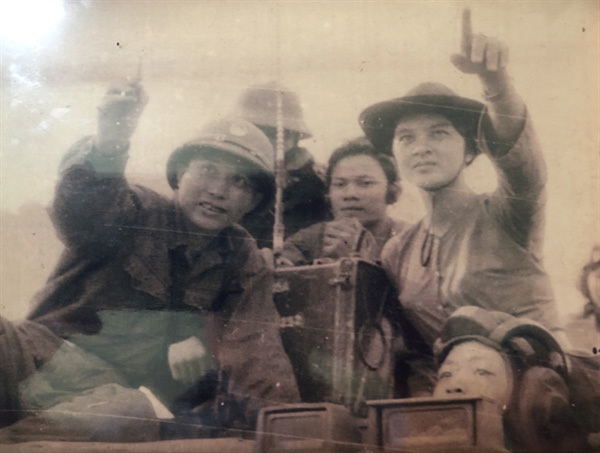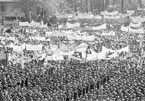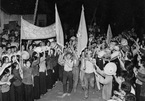 |
| The photo featuring Nguyen Thi Ngoc My (first from right) sitting on the tank of the Vietnamese troop and led them the way to the US army in Cu Chi District in the night of April 29, 1975. VNA/VNS Photo |
My, who was in her 20s at the time, showed the Vietnamese troops the way to the enemy battalion, which was reinforced to fight the Vietnamese army in Lai Thieu District.
The US battalion was surrounded, forcing the enemy in the headquarters to surrender. The Vietnamese troops quickly captured Vinh Binh Province (now Tra Vinh Province) and Lai Thieu iron bridge.
My was born and raised in Vinh Phu Commune in Thu Dau Mot Province (now Binh Duong Province). She dropped out of school after finishing grade two due to poverty.
My stayed at home, did chores to help her parents and started delivering messages between undercover revolutionaries in the enemy-occupied zone in Vinh Phu Commune.
At the age of 16, My was assigned to get information from the US troops and the southern puppet government and pass it to revolutionary officials.
She was also tasked with mobilising young people in her village to participate in the revolution.
During the Mau Than General Offensive and Uprising in Spring 1968, My made flags and took food and ammunition into revolutionary bases.
On the first days of the Tet (Lunar New Year) in 1968, My carried wounded soldiers on oxcarts from the inner city of Sai Gon to field hospitals in the revolutionary base.
In the next months, enemy troops counterattacked in both the inner city and the Sai Gon suburbs. Some revolutionary bases in Vinh Phu were captured.
My was assigned to move to Thuan An Hoa war zone (now Thuan Giao Ward in Binh Duong). She joined a four-month nursing class held by Di An Military Army on the banks of the Be River.
When My had almost finished the course, the enemy suddenly launched a raid on the base.
She was ordered to move to Tan Thoi Commune in Thu Dau Mot Province (now Thuan An City in Binh Duong) where she was arrested. She was 18 at the time.
After eight days of torture and interrogation, My was released.
In early 1970, My was told to return to her family and work as a secretariat of the Youth Union of Vinh Phu, but she was soon arrested again.
This time, the enemy used all sorts of torture, including electric batons to try and force her to divulge information on her fellow revolutionaries.
She was imprisoned in a dungeon for two months but My stayed silent, so the enemy was forced to release her in May 1970.
Once out of prison, My continued her work building a revolutionary base in the enemy zone in her hometown.
Three years later, she was admitted to the Communist Party of Vietnam. My was under tight observation of the US army.
She was forced to leave her family to live in the forest and continued her revolutionary path. In 1974, My was selected as the secretariat of Lai Thieu District’s Youth Union. She was in charge of seeking information on the enemy and reporting to Vietnamese soldiers.
On the night of April 29, 1975, the sound of gunfire was severe. My was riding her bike to the revolutionary base as usual and met commander Nguyen Huy Hieu and his Regiment 27.
Although they were informed about the positions of the enemy and supplied with a map, the regiment struggled to manoeuvre on the unfamiliar roads.
My decided to lead the way for the Vietnamese troops and she climbed onto the leading tank and helped the troops fight the US army in Cu Chi District.
The victory led to the surrender of the enemy in the district and a series of victories in the province.
After the liberation of Sai Gon, My worked in several positions in her local authority until she retired in November 2002. VNS
Nguyen Van Viet

Ho Chi Minh Campaign – Strategic battle
The general offensive in the spring of 1975, with the historic Ho Chi Minh Campaign as its pinnacle, ended successfully, leading to the ultimate victory of the resistance war against the US aggressors and the country's reunification.

Intellectuals respond for Southern Liberation
The 1970s was a time of huge significance in Vietnamese history, not least for the generation who responded to the movement 'Putting away pens to go to the battle'.
 Nguyen Thi Ngoc My has never forgotten the moment she volunteered to climb on top of the tank and led Vietnamese soldiers to US troops in Cu Chi District, contributing to the liberation of Sai Gon on April 30, 1975.
Nguyen Thi Ngoc My has never forgotten the moment she volunteered to climb on top of the tank and led Vietnamese soldiers to US troops in Cu Chi District, contributing to the liberation of Sai Gon on April 30, 1975.